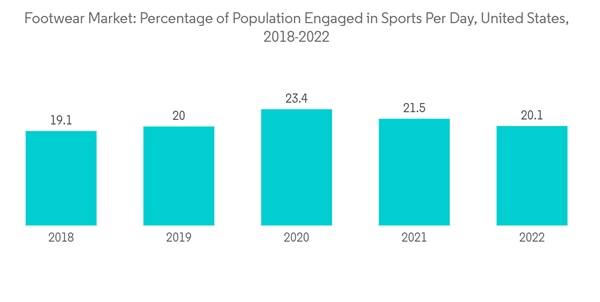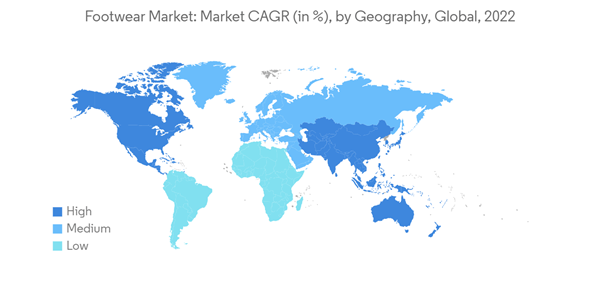The footwear market size is expected to grow from USD 410.58 billion in 2024 to USD 530.28 billion by 2029, at a CAGR of 5.25% during the forecast period (2024-2029).
This product will be delivered within 2 business days.
Key Highlights
- The rising demand for fashionable, trendy, yet comfortable footwear across all age groups is a key factor driving the global footwear industry. The rise in the growth of sports-focused footwear, such as football, cricket, basketball, and golf, coupled with exponential investment by governments and global organizations to promote sports leagues and participation, has been a key driver for the market.
- Asian countries, such as China and India, are the major exporters of leather footwear across developed countries. For instance, according to the Department for Promotion of Industry and Internal Trade, it is estimated that about USD 2,047.08 million worth of leather footwear products was exported from India to other parts of the world in 2022.
- Additionally, an emerging trend in the global footwear market is the rise in demand for eco-friendly footwear. There has been a growth in the usage of sustainable materials and sustainable footwear brands that have embedded sustainability into their brands from their beginnings. The manufacturers have been finding innovative ways to manufacture such products to suit customer demands.
- For instance, in August 2022, Solecraft, an indigenous sustainable footwear company in India, announced the launch of its first pair of sweat-resistant charcoal shoes. The company claimed that only natural materials were used in the manufacturing of these eco-friendly sneakers. The company revealed that the product was developed in India and manufactured using Japanese bamboo charcoal, premium Australian Merino wool, and plant-based recycled coffee grounds oil.
- Athleisure has become more pervasive, as it has influenced the athletic footwear choice among millennial parents. Due to this factor, they are dressing their kids in athletic apparel and footwear. This is driving the sales of overall footwear across the world.
- Non-athleisure footwear products such as boots, sandals, and flip-flops are commonly used by the consumer in day-to-day life. Hence, manufacturers in the market are focusing on innovative and user-friendly designs to attract consumers. Moreover, sneakers stand out to be one of the popular types of footwear products across the market owing to the comfort and design of the products. Sneakers were popular among young consumers. They often tend to buy expensive pairs of sneakers as an investment and enthusiasm towards exclusive collections available across the market.
Footwear Market Trends
Potential Increase in Demand for the Athletic Footwear Segment
- Growing enthusiasm and awareness regarding the health benefits of sports and fitness activities, the flourishing retail e-commerce sector worldwide, and rising levels of disposable income of consumers are the key factors facilitating segment growth. Rising health concerns because of a sedentary lifestyle and the resultant problems caused by it are benefitting athletic footwear demand. This influences people to actively take part in both indoor and outdoor physical activities.
- Sports such as soccer, basketball, tennis, badminton, and other physical activities such as running, gymming, and others have become common among consumers. For instance, according to Sports England, it is estimated that about 5,896.8 participated in running, 4,842.6 in gym sessions, and 2,012.3 participated in soccer and other physical activities at least twice a month in England between 2021 and 2022. These sports require a certain amount of physical fitness and minimum equipment, such as shoes that protect feet and give comfort while performing the activity. These factors encourage the customer to buy or own more than one pair of footwear dedicated to the sport, resulting in increasing the sales of the footwear in the market.
- Moreover, major global sporting events held periodically, like the Olympics, Commonwealth Games, Asian Games, Cricket World Cup, Super Bowl, and FIFA World Cup, also boost the demand from both athletes and non-athletes individuals. For example, in March 2022, Puma partnered with Lega Serie A. Puma to be a technical partner of the football league and was the official supplier of athleisure and football for all matches in Europe. The footwear market has seen a steep rise in the demand for athletic footwear emerging from lifestyle users, owing to the growing health consciousness.
Asia-Pacific Holds a Prominent Share in Footwear Industry
- China and India alone account for nearly one-third of the global population, and this ensures that the Asia-Pacific is the largest footwear market in the world. Countries are likely to maintain their lead as combined. They comprise almost 40% of the entire global footwear market. This can be attributed to several factors, like rapid urbanization and a preference to adopt a Western lifestyle and/or brands, especially in the middle class and rich society. The region is also home to many multinational sports equipment companies that are often at the forefront of innovation. They will likely lead the world in developing new footwear that fulfills both the penchant for design and a preference for superior quality.
- According to the Thailand Textile Institute, around USD 2.16 billion worth of leatherwear and footwear products were imported into Thailand in 2022. Thailand's imports of leather clothing and footwear grew in value that year compared to the year before. According to World Footwear, Asia alone accounted for approximately 87.4% of the world's footwear production in 2022, reflecting the region's significant concentration of the footwear manufacturing industry. This was due to the availability of cheap labor and raw materials, which allowed the manufacturers to produce the footwear at lower prices in bulk amounts. This has led to the availability of numerous options in the footwear category at competitive prices, which drives the market studied across the region.
- Moreover, the footwear industry in Asia-Pacific has been gaining traction in recent years, given people's awareness and consciousness about health and ongoing fashion trends. This has led to a slew of new players, most of whom bank on affordable price points to dive into the masses, mostly in smaller cities and towns. These brands buttress online retailers like Amazon, Flipkart, Rakuten, Foot Locker, and Myntra to penetrate the Asia-Pacific market.
Footwear Industry Overview
The global athletic footwear market is highly competitive, with major market share held by prominent players, such as Puma SE, Nike Inc., Adidas AG, LVHM, Keringa SA, and Puma SE. This is attributable to its higher market penetration, reflecting a strong industry grip through its brands, products, partnerships, and advertising. These progressive brands have laid their hand on every possible strategy to cater to the footwear market's demand, which includes employing aggressive digital campaigns, offering a wide range of innovative and customizable products, including sustainable footwear, unique and gender-neutral designs that cater to the preferences of all age groups, including athletic shoes specifically designed for kids, and brand collaborations.Additional Benefits:
- The market estimate (ME) sheet in Excel format
- 3 months of analyst support
This product will be delivered within 2 business days.
Table of Contents
1 INTRODUCTION
4 MARKET DYNAMICS
5 MARKET SEGMENTATION
6 COMPETITIVE LANDSCAPE
Companies Mentioned (Partial List)
A selection of companies mentioned in this report includes, but is not limited to:
- Nike Inc.
- Adidas AG
- New Balance Inc.
- Asics Corporation.
- Skechers USA Inc.
- Fila Holdings Corp.
- The Bata Corporation
- VF Corporation
- Puma SE
- Under Armour
Methodology

LOADING...










